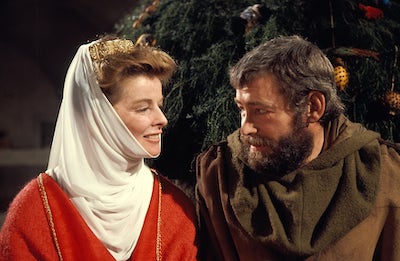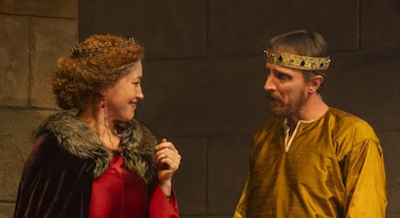Media and Storytelling
As someone who didn’t watch old movies or know anything about theater growing up, I was completely oblivious to the cultural force that is the 1968 film adaptation of The Lion in Winter. So many of my classmates know and love this movie, and those who came to see the production at Court found that their experience as audience members was colored by their familiarity with and love of the piece. One of my classmates, prior to attending Court’s production, even called the film “perfect” and posited that its artistic excellence seemed impossible to recreate.

I saw the show with a friend of mine, and neither of us had seen the film. Since we had to run to the theater directly from a late class, we also hadn’t had time to do our customary pre-show research. We came into the show with zero expectations and zero preparation. (Anyone in the audience who saw our jaws physically drop upon the Philip/Richard relationship reveal could easily confirm that.) I don’t usually show up clueless to performances because I find that knowing how others think about a work is part of the fun of watching it. In this case, however, my lack of information actually deepened my experience.
Theater artists often avoid watching previous productions of a show they’re currently working on to avoid getting bogged down in someone else’s vision, therefore ensuring that their own creative choices shine through in the work. This is also true of movie adaptations — in my opinion, avoiding artistic influence from different forms of media is especially crucial. The script doesn’t always change between adaptations, so when there’s a change in media format, it becomes exponentially more challenging to make the things you love about a previous adaptation your own. The context in which that work is created is inherently different from the context for your own creative process, and that influence might run deeper than initially meets the eye.
The Lion in Winter is an incredible example. After hearing my classmates’ opinions on both the film adaptation and Court production, I figured I had to watch the movie and form my own opinion. I found that both versions of The Lion in Winter were beautifully acted, expertly designed, and put together with that sense of reverence and care for the text that defines good classic theater. I did not find any substantive difference in quality or inherent artistic value between the two. However, the difference in medium created products with vastly different focuses and emotional cores.
In film, creatives have access to resources that aren’t accessible in theater — resources that widen the scope of a work. While the 1968 movie had access to a castle set and large teams of extras, the stage version only has access to its lead actors and a single, though versatile, room. Therefore, in the film adaptation, we get to see battles, banquets, marketplaces, and large stretches of land, driving home the point that everything our protagonists do affects entire countries. We, as an audience, see the Plantagenet family’s subjects and the sheer size of their residence, and we cannot forget that every decision and petty fight between them has the potential to mean another war and another thousand dead peasants.
On the stage, the scope of the work narrows and the play changes shape, becoming a true family drama. The audience knows that the people they’re watching are obscenely powerful; the text is certainly a reminder that the characters could deploy an army or annex a province at any time. However, we don’t see anyone outside of the family. The story stops being about whole countries and starts being about seven relatives in a power struggle. They are fighting over the fate of a nation, certainly, but they could just as well be fighting over where to go on vacation or who gets to host Christmas that year. The core of the play is truly the family unit, and we get to see our own families and the ones we watch on TV and in movies represented in it.

So, while the film version is framed to convince its audience of how high the socio-political stakes of the Plantagenet and Capet families’ Christmas arguments are, the stage version is framed to remind us of how high the emotional stakes are. They are simultaneously the same work and extremely different works, and although that certainly has a lot to do with artistic choices from their respective creative teams, it has just as much to do with the intricacies of different forms of performed media. The Lion in Winter is an incredible case study in how media format can reframe a work, which makes a marathon of our production and the movie adaptation a worthy double feature.
Eleni Lefakis is a third-year undergraduate studying Theater and Performance Studies at the University of Chicago. She currently serves as Outreach Chair for University Theater at UChicago’s executive committee and manages Occam’s Razor, UChicago’s independent improv comedy group. Outside of UChicago, she has worked as a production fellow for Lykofos Productions in Athens, Greece and as an artist-in-residence at Teatro del Presagio in Cali, Colombia.
1 response on “Media and Storytelling”
Comments are closed.
I agree with the focus of your comparison. I also was interested to see the actors put their own interpretation of the characters and was pleasantly surprised and impressed with their talent. I must admit the musical score for the movie was very impressive and the opening music set the tone for the historical connection. It was the one thing lacking in the stage production but understandable. That being said the actors did an amazing job. It brought a different dimension and interpretation that was enjoyable! Well done